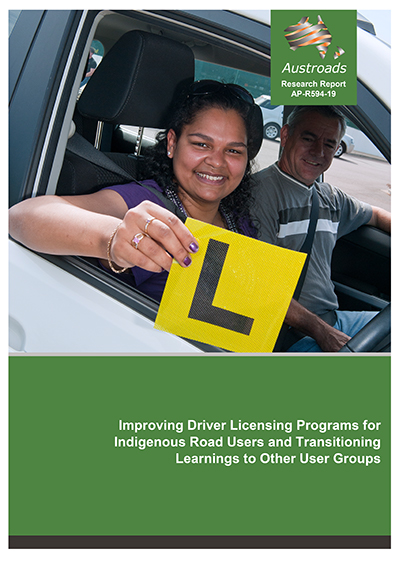Registration and Licensing

Improving Driver Licensing Programs for Indigenous Road Users and Transitioning Learnings to Other User Groups
- Publication no: AP-R594-19
- ISBN: 978-1-925671-93-3
- Published: 10 January 2019
- PDF (free) Download
Lack of appropriate access to driver licensing services is a barrier to employment, economic participation and access to government and non-government services by Indigenous people and other road user groups.
This project provides:
- service design proposals to mitigate licensing barriers to increase licence ownership and retention among Indigenous and other road users; and
- a proposed minimum data set and data sharing arrangement to inform the development and delivery of best practice driver licensing services for Indigenous and other road users.
- Summary
- 1. Introduction
- 1.1 Introduction and Background
- 1.2 Methodology
- 2. Literature Review
- 2.1 International Literature
- 2.2 Australian Literature
- 2.2.1 Introduction
- 2.2.2 Transport Disadvantage
- 2.2.3 Road Safety Outcomes
- 2.2.4 Licence-related Interaction with the Justice System
- 2.2.5 Barriers to Driver Licence Acquisition for Indigenous People
- 2.2.6 Licensing Access for Other Road User Groups
- 2.3 Jurisdiction-specific Program Reports
- 2.3.1 Queensland
- 2.3.2 New South Wales
- 2.3.3 Northern Territory
- 2.3.4 South Australia
- 2.3.5 Western Australia
- 3. Jurisdictional Consultation
- 3.1 Current Programs
- 3.2 Program Context
- 3.3 Future Programs
- 3.4 Towards National Policy and Program Guidelines
- 4. Discussion
- 4.1 Summary of Findings
- 4.2 Social Impact of Licensing
- 4.3 Data Collection
- 4.4 Costs and Benefits
- 5. Program Logic
- 5.1 The Logic Model as a Tool for Program Design and Development
- 5.2 Four-level Logic Model of the Indigenous Licensing Project
- 5.2.1 Strand One - Working towards National Policy Principles
- 5.2.2 Strand Two - Mitigating Systemic, Countervailing Policy and Program Barriers
- 5.2.3 Strand Three - Connecting Related and Supporting Initiatives
- 5.2.4 Strand Four - Establishing a Minimum Data Set and Reporting Arrangements
- 5.2.5 Impacting Factors
- 6. National Policy Principles
- 6.1 Policy Principles
- 6.1.1 Principle One - Removing and Mitigating Barriers to Participation
- 6.1.2 Principle Two - Program Design Promoting Participation and Outcomes
- 6.1.3 Principle Three - Flexible Design and Contextualised Programs
- 6.1.4 Principle Four - Culturally Secure Design and Delivery
- 6.1.5 Principle Five - Community Engagement and Ownership
- 6.1.6 Principle Six - Predictable and Consistent Program Delivery
- 6.1.7 Principle Seven - Collaborative Practice, Shared Resources and Data
- 6.2 Application of National Principles
- 6.3 Key Program Delivery Strategies
- 6.1 Policy Principles
- 7. Minimum National Data Set
- 7.1 Minimum Data Requirements
- 7.1.1 The Proposed National Minimum Data Set
- 7.1.2 The Standard Indigenous Status Question
- 7.2 National Data Sharing and Reporting Framework
- 7.3 Austroads Data and Resource Library
- 7.1 Minimum Data Requirements
- 8. Conclusion
- Appendix A Program Descriptions
Related publications
FORUM-EOI-DTS-24
WEB-G107-24
Latest Registration and Licensing News
